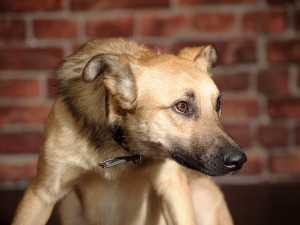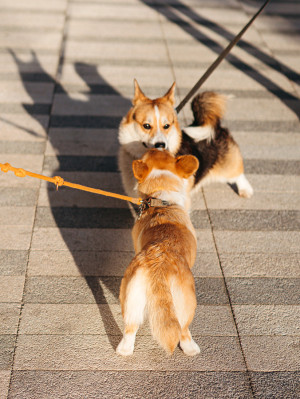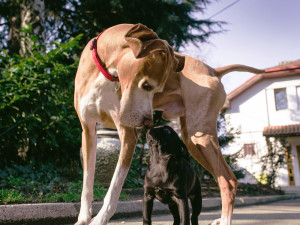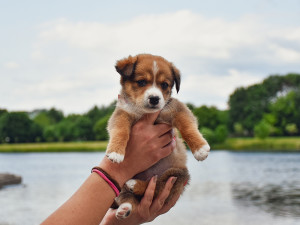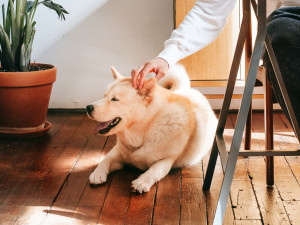Does Your Dog Fixate on Other Dogs? Here’s How to Get Them to Walk Away
Stop them before a stare turns into a fight.

Share Article
Every dog owner has experienced this: you’re walking your dog and as you approach another person walking their dog, your pup stops. Their body goes rigid and they stare at the other dog with an intensity that only a dog can muster. It's as if everything around them has melted away and all that exists in the universe is the two of them. Sometimes a word from you is all it takes to break their focus and move them along, but other times, especially when the other dog is staring back, getting your pup to disengage can be a real challenge. And failing to do so can have disastrous consequences.
“Intense eye contact for dogs is very confrontational and can lead to aggression,” says Annie-Mae Levy, a dog trainer at Woofzopens in a new tab with a BS in animal behavior. “That’s why it is so important to have a plan in place, because once your dog fixates, things can escalate quickly — from barking, to lunging, to a full-blown fight.”

Save on the litter with color-changing tech that helps you better care for your cat.
Why do dogs fixate on each other?
Dogs fixate on each other for a number of reasons, many of them completely benign. They might want to play or find themselves with a lot of pent-up energy they don’t know what to do with. They could be curious about this other dog, or anticipating a greeting or some other form of interaction.
Younger dogs might not yet know how to read the body language of other dogs, so they might fixate while trying to figure a new dog out.
“The breed also plays a role,” says Levy. “Herding or hunting dogs, for example, may ‘lock on’ to things more easily.”
“Dogs also fixate when they are getting ready to defend themselves,” says Sally Grotini, a certified trainer of service and therapy dogs and dog behavior expert at JustAnsweropens in a new tab. “They may also have a possessive aggressive temperament or be possessive of their human.” It’s also possible they have a naturally fearful temperament, which causes them to fixate more easily. These fear-based fixations are the ones most likely to lead to a fight, because even if your dog isn’t particularly aggressive or possessive, the dog they are fixating on might be. And it only takes one dog to start a fight.
What should you do if you notice your dog fixating?
First and foremost, don’t yank the leash. “Yanking the leash can actually cause the dog to act out faster,” says Grottini. “If a dog is fixed on a fight, yanking on the dog can put them in motion to do so.”
Levy agrees. “Yanking on the leash might seem like a quick fix, but it can actually make things worse. It can even lead to the dog associating the discomfort they feel at being yanked with the other dog, which could make them even more reactive next time.”
Yanking on your dog’s leash can also hurt your dog’s neck, and saving your dog from getting hurt is the whole point of breaking their fixation in the first place.
Instead, try blocking your dog’s view of the other dog. This can be as simple as slowly walking in front of your dog and then leading them away, as shown in this Instagram reel from South End Dog Trainingopens in a new tab. If that doesn’t work, try getting down on the dog’s level and fully blocking their view of the other dog. This should be enough to distract them to the point where you can redirect them away from the object of their fixation. If all else fails, you can use gentle pressure to move them along, but, again, don’t yank them. Use your hands to gently direct them where you want to go.
Grottini also recommends keeping a favorite toy or high-value treat like chicken slivers in your pocket that you can pull out if your dog doesn’t want to give you their attention.
Alternately, you may just need to walk your dog in a less crowded area, where there are fewer dogs for them to fixate on.
Can you train your dog not to fixate in the first place?
While you can’t train fixation behavior out of your dog entirely, you can train them to drop their fixation and return their attention to you.
Levy recommends starting with a “look at me” command. Teach your dog the command at home, away from other dogs. Once the command is perfected, take them to a location where other dogs are present, but far away, and train the command again. Over time, you can move closer to the other dogs. Reinforce their behavior by rewarding them every time they glance at another dog and then return their attention to you. “It’s like building a habit,” says Levy. “They need to learn that it is rewarding to glance at things and then back at you.”
Grottini recommends a similar command: “leave it,” which, when properly trained, can be used to get a dog to drop any fixation, whether it is another dog, a person, a car, or a piece of food on the sidewalk. “Many people do not train this command long enough as it should be trained for at least six months and trained with all sorts of items, people, other dogs, cars, etc. Anything you think the dog will encounter; this command should be taught around,” says Grottini.
What if you notice another dog fixating on your dog?
There is no predicting or controlling what another person’s dog will do. Try to stop your own dog from staring back — using treats, a clicker, or well-trained commands like the ones discussed above — and then put some distance between both dogs.
“It’s also important to stay calm and not overreact,” says Levy. “Because your dog is going to take cues from your behavior.”
At what point should you seek help from a trainer?
Training dogs is hard. Especially when you are trying to train them out of a reactive behavior like fixation. For this reason, both Grottini and Levy recommend seeking professional help sooner, rather than later. “If your dog’s fixations are constant and it’s leading to reactive or aggressive behavior, it’s time to get help from a professional trainer,” says Levy. “They can figure out if your dog is acting out of fear or excitement, or something else, and give you a solid idea on how to manage it.” They can help you practice commands and make sure you have all the tools you need to keep your dog and yourself safe.

Charles Manning
Charles Manning is an actor, writer, and fashion/media consultant living in New York City with his two cats, Pumpkin and Bear. Follow him on Instagram @charlesemanningopens in a new tab.
Related articles
![Two dogs acting rowdy at the lake while a person tries to calm them down]() opens in a new tab
opens in a new tabMy Dog Is Misbehaving. What Should I Do?
Don’t blame the dog — instead, figure out how to help them succeed.
- opens in a new tab
How to Manage Leash Reactivity in Your Dog
If your pup acts diabolical on walks, you are not alone. Here’s what you can do.
![two dogs meeting on leashes]() opens in a new tab
opens in a new tabSeriously, Your Dog Does Not Want to Meet Another Dog On-Leash
Trainer Charlie DiBono warns against these greetings on all fronts.
![Big dog sniffs little dog in greeting]() opens in a new tab
opens in a new tabHow to Properly Introduce Two Pups
There’s a lot more to it than sniffing each other’s butts.
![Two hands holding a very young tan and white puppy up in front of a lake landscape]()
How to Socialize a Puppy
Everything you need to know to get your new addition off to a good start.
![Unrecognizable man sitting at desk petting his dog]() opens in a new tab
opens in a new tabHow to Pet a Dog — Yes, You Do Need Lessons
There’s a difference between being affectionate and being annoying.

